Journal of Water Resource and Protection
Vol. 3 No. 2 (2011) , Article ID: 4055 , 9 pages DOI:10.4236/jwarp.2011.32012
Adsorption of Quaternary Ammonium Compounds onto Activated Sludge
College of Environmental Science and Engineering/Tianjin Key Laboratory of Environmental Remediation and Pollution Control/Ministry of Education Key Laboratory of Pollution Processes and Environmental Criteria, Nankai University, Tianjin, China
E-mail: Likx@nankai.edu.cn
Received November 28, 2010; revised January 3, 2011; accepted February 8, 2011
Keywords: Activated Sludge, Adsorption, Kinetics, Quaternary Ammonium Compounds, Thermodynamics Analysis
ABSTRACT
The performance of activated sludge in the removal of tetradecyl benzyl dimethyl ammonium chloride (C14BDMA) by adsorption from aqueous solution was investigated with different PH, contact time, ionic strength and temperature. Equilibrium was achieved within 2 h of contact time. The adsorption capacity increased largely with increasing solution pH and remained constant above pH 9. The ionic strength had a negative effect on C14BDMA removal. The adsorption isotherms were analyzed by Langmuir and Freundlich isotherm models, and equilibrium partitioning data was described well by both models. Kinetics data was best described by the pseudo second-order model. Experimental results indicated that the adsorption was favorable at lower temperatures. Thermodynamic parameters, including the Gibbs free energy (ΔG0), enthalpy (ΔH0), and entropy (ΔS0), were also calculated. These parameters indicated that adsorption of C14BDMA onto activated sludge was feasible, spontaneous and exothermic in the temperature range of 15-35℃ . The activated sludge was shown to be an effective adsorbent for C14BDMA.
1. Introduction
Quaternary ammonium compounds (QACs) are molecules with at least one hydrophobic hydrocarbon chain linked to a positively charged nitrogen atom with other alkyl or aryl groups being mostly short-chain substituent [1]. QACs belong to the group of cationic surfactants. Because of their unique physical/chemical properties, QACs are primarily used as disinfectants, biocides or detergents, but QACs are also used as anti-electrostatics and phase transfer catalysts in a wide range of applications [2].
The widespread use of QACs causes them to be released and to accumulate in aquatic environments and wastewater treatment plants (WWTPs) [3-4]. Due to their biocidal properties they may have potential impacts on organisms in activated sludge. It was revealed in literature that QACs had an adverse effect on nitrification [5] and denitrification [6]. Moreover, it was reported that QACs, at a concentration of 50 mg L-1, adversely affected the anaerobic degradation, which resulted in significantly reduced methane production and accumulation of volatile fatty acids [7]. Due to the hydrophobic and electrostatic interactions, QACs can rapidly adsorb onto solids and extensively accumulate in aquatic sediments [4, 8-10] . The adsorption of QACs has been studied previously using various adsorbents, such as coal [11], clinoptilolite [12], and activated carbon [13-15] .
Activated sludge is a well-known biomass used for the purification of both industrial effluent and domestic wastes. Although a large number of studies have reported on biosorption of heavy metals as well as organic pollutants onto activated sludge [16-18] , there have been few studies on the use of sludge to remove QACs [19-22] . Garcia et al. [20] investigated the adsorption isotherms on activated sludge from wastewater treatment plants and surface properties in aqueous solutions of alkyl benzyl dimethyl ammonium compounds (BAC). They reported that the Langmuir and Freundlich isotherms agreed very well with experimental data, and adsorption capacity increased with increasing the alkyl chain length.
The objective of this study was to investigate the adsorption potential of activated sludge for removal of Tetradecyl benzyl dimethyl ammonium chloride (C14BDMA), which is one of the most commonly used QACs. Effects of different parameters, such as pH, contact time, temperature and ionic strength on the adsorption were investigated. The adsorption thermodynamics and kinetics of C14BDMA onto activated sludge were evaluated.
2. Materials and Methods
2.1. Preparation of the Adsorbent
The activated sludge used in this study was obtained from the wastewater treatment plant of the Technical and Economic Development Area (TEDA) in Tianjin, China. The activated sludge was centrifuged at 1750 g for 5 min and washed twice with DI water to remove easily suspended materials. The remaining solids were placed into flasks, immediately inactivated by autoclaving (120℃, 30 min), and then stored at 4℃ to ensure that only the adsorption effect, rather than a combined adsorption and degradation effect, was assessed.
2.2. Chemicals
Tetradecyl benzyl dimethyl ammonium chloride (C14BDMA, C23H42NCl, 368.0 g mol-1) used in this study was purchased from Shanghai Jinchun company in China and was used without further purification. Stock solution (10 g L-1) of C14BDMA was prepared based on the active ingredient purity and concentration and was used in all experiments after dilution with DI water.
2.3. Adsorption Experiments
Kinetic removal of C14BDMA was performed as follows: batch experiments were conducted using 250 mL screw-topped flasks, and the mixed liquor suspended solids (MLSS) was 250 mg L-1. A sample of C14BDMA solution was then added to attain the desired initial C14BDMA concentrations (5, 20, 50 mg L-1). The flasks were sealed with stoppers and shaken at a rate of 150 rpm with a shaker at room temperature, and samples were obtained at given time intervals (0, 0.25, 0.5, 1, 2, 4 and 8 h). After centrifugation (11,410 g for 15 min), the liquid phase concentration was measured, and the mass of C14BDMA adsorbed to the sludge was calculated based on the difference between the total and aqueous C14BDMA mass. Blank experiments were carried out with C14BDMA solution and without adsorbent to ensure that no C14BDMA was adsorbed onto the walls of the flasks.
Adsorption isotherm assays were determined at initial C14BDMA concentrations of 10, 20, 40, 60, 80, 100, 120, 140 mg L-1 and 250 mg L-1 sludge concentration (MLSS). The flasks were shaken at a rate of 150 rpm with a shaker for 4 h. The experiments were repeated at 15, 25, and 35℃. When the sorption procedure was completed, the samples and data were treated in the same way as in the kinetic experiments.
In order to evaluate the effect of pH and ionic strength on the adsorption of C14BDMA onto activated sludge, the adsorption experiments were carried out over a pH range of 1-13 and the concentrations of NaCl ranging from 0 to 0.40 mol L-1, respectively.
2.4. Analytical Methods
The concentrations of QACs in whole and centrifuged sludge samples were determined by using the previously reported modified disulfine blue (DSB) method [23]. The Mixed liquor suspended solids (MLSS), mixed liquor volatile suspended solids (MLVSS) and pH were measured according to the Standard [24].
3. Results and Discussion
3.1. Effect of Contact Time
In order to establish the equilibration time for maximum uptake, the adsorption of C14BDMA onto activated sludge was studied as a function of contact time.
The adsorption rate was high at the beginning, and equilibrium adsorption of C14BDMA onto activated sludge was achieved within 2 h (Figure 1). Therefore the equilibration period of 4 h was selected for all further experiments. The rapid attainment of equilibrium was consistent with previously published reports on the adsorption of cationic surfactants onto sludge. Ismail et al. [21] investigated the batch adsorption of four tested QACs to sludge and reported the optimum equilibrium time as 4 h. All the systems studied by Garcia et al. [25] to determine the rate of BAC adsorption onto activated sludge achieved equilibrium within three hours.
Figure 1 also shows that the uptake of the C14BDMA increased with increasing initial C14BDMA concentration. Raising the initial C14BDMA concentration from 5 to 50 mg L-1 allows the sludge to increase the adsorption capacity from 17.61 to 148.5 mg g-1. The results are in agreement with literature on the adsorption of organic substances onto activated sludge [26,27]. This is due to an increase in the driving force of the concentration gradient as an increase in the initial adsorbate concentration. The initial concentration is an important driving force to overcome all mass transfer resistances of the C14BDMA

Figure 1. Kinetic study for C14BDMA adsorption onto activated sludge. (MLSS: 0.25 g L-1; temperature: 25℃). (Error bars represent one standard deviation of the means).
between the aqueous and solid phases. Thus, a higher initial concentration would enhance the adsorption process.
3.2. Adsorption Kinetics
The adsorption kinetics data is extremely important to understand the mechanism of the adsorption and to assess the performance of the adsorbents. The pseudo firstorder adsorption [28], the pseudo second-order adsorption [29] and the intra-particle diffusion models [30] were used to fit the experimental data.
The parameters in the psuedo first and second-order models determined from the linear plots of ln (qe − qt) versus t (Figure 2) and t/qt versus t (Figure 3) are given in Table 1. The correlation coefficients (R2) for the pseudo first-order model, were relatively too low, which may be indicative of a bad correlation. The qecal values determined from the model were not consistent with the experimental values of qe (not shown in the table). Therefore, the pseudo first-order reaction is not suitable for adsorption of C14BDMA onto sludge. However, the correlation coefficients for the pseudo second-order kinetic model are close to 1.0 for all cases (R2 = 0.999), and the theoretical values of qec were in agreement with the experimental data qe. Based on these results, the adsorption of C14BDMA onto activated sludge followed the pseudo second-order process rather than pseudo firstorder. The results presented in this study are comparable to a study which investigated the biosorption of cationic surfactants by using activated carbon cloth [14].

Figure 2. Linearized pseudo first-order kinetic model for adsorption of C14BDMA onto activated sludge at various initial concentration. (MLSS: 0.25 g L-1; temperature: 25℃). (Error bars represent one standard deviation of the means).
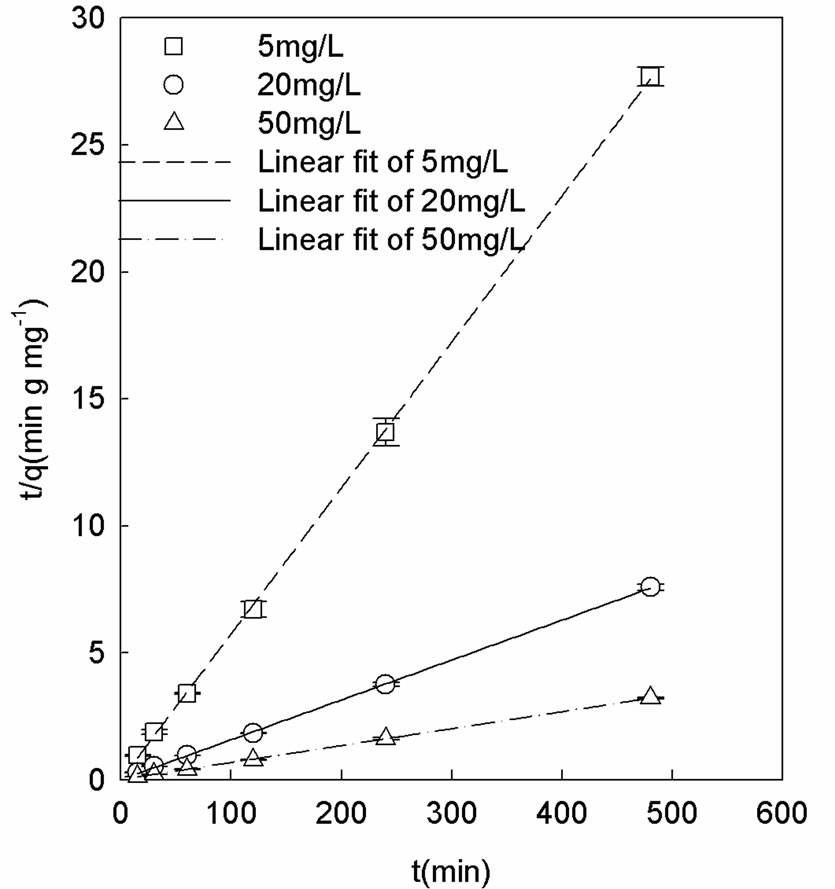
Figure 3. Linearized pseudo second-order kinetic model for adsorption of C14BDMA onto activated sludge at various initial concentration. (MLSS: 0.25 g L-1; temperature: 25 ℃). (Error bars represent one standard deviation of the means).
The psuedo first and second-order models basically include all steps of sorption, such as external film diffusion, sorption, and internal particle diffusion, so they are

Table 1. Pseudo first-order and pseudo second-order adsorption rate constants of C14BDMA onto activated sludge at different initial concentration.
considered pseudo-models. Neither model identifies the sorption mechanism, so the intra-particle diffusion model was tested in this work. According to previous studies, the intra-particle diffusion plot may represent multilinearity, indicating that two or more steps occur [31-33] . The first portion (sharper) is the external surfaces sorption or instantaneous sorption stage. The second portion is the gradual sorption stage, where intra-particle diffusion is rate-controlled. The third portion is the final equilibrium stage, where intra-particle diffusion starts to slow down due to extremely low solute concentrations in the solution.
The intra-particle diffusion plot for the sorption of C14BDMA is shown in Figure 4. It was observed that the data points were related by two straight lines and the plots did not pass through the origin. The deviation of the straight lines from the origin may be due to the difference in the rate of mass transfer during the initial and
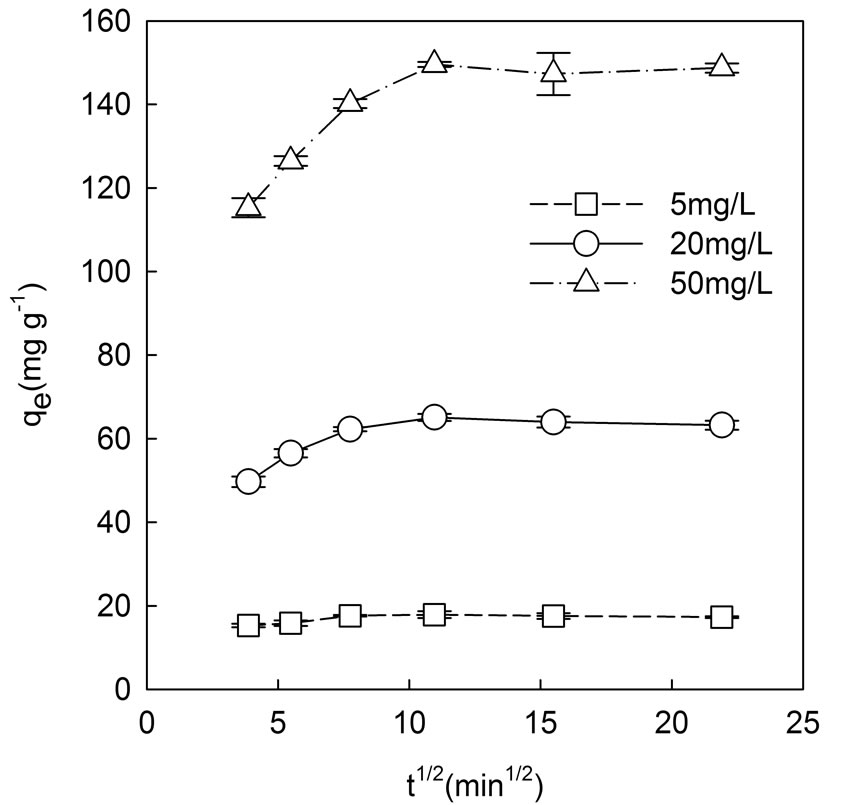
Figure 4. Intra-particle diffusion model for adsorption of C14BDMA onto activated sludge at various initial concentrations. (MLSS: 0.25 g L-1; temperature: 25℃). (Error bars represent one standard deviation of the means).
final stages of adsorption. The intercepts, obtained by extrapolation of the linear portion of the plots, provide the boundary layer thickness. The initial curved portion is attributed to boundary layer diffusion effects or external mass transfer effects [34,35]. These effects indicated that intra-particle diffusion was not the only rate-limiting step; also, other kinetic models, such as surface adsorption, may control the rate of adsorption.
3.3. Adsorption Isotherms
The experiments were carried out with initial C14BDMA concentrations in the range of 10-140 mg L-1 at 25℃. The sludge concentration (MLSS) was 250 mg L-1 and contact time was 4 h.
The equilibrium data was fitted with the Langmuir [36] and Freundlich [37] isotherm models. The Langmuir parameters, qm, which is the maximum amount of adsorption and KL, which is the Langmuir adsorption constant, obtained from the equation of plot of qe versus Ce (Figure 5), were found to be 368.3 mg g-1 and 0.047 L mg-1, with a correlation coefficient (R2) of 0.984; results are listed in Table 2. The fitted results indicate that the Langmuir isotherm model was applicable to describing the C14BDMA adsorption equilibrium by inactivated sludge.
The Freundlich adsorption isotherms are also shown in Figure 5. The values of KF which is the constant related to the adsorption capacity obtained in this study are higher than previously reported values [21,38]. The KF and n
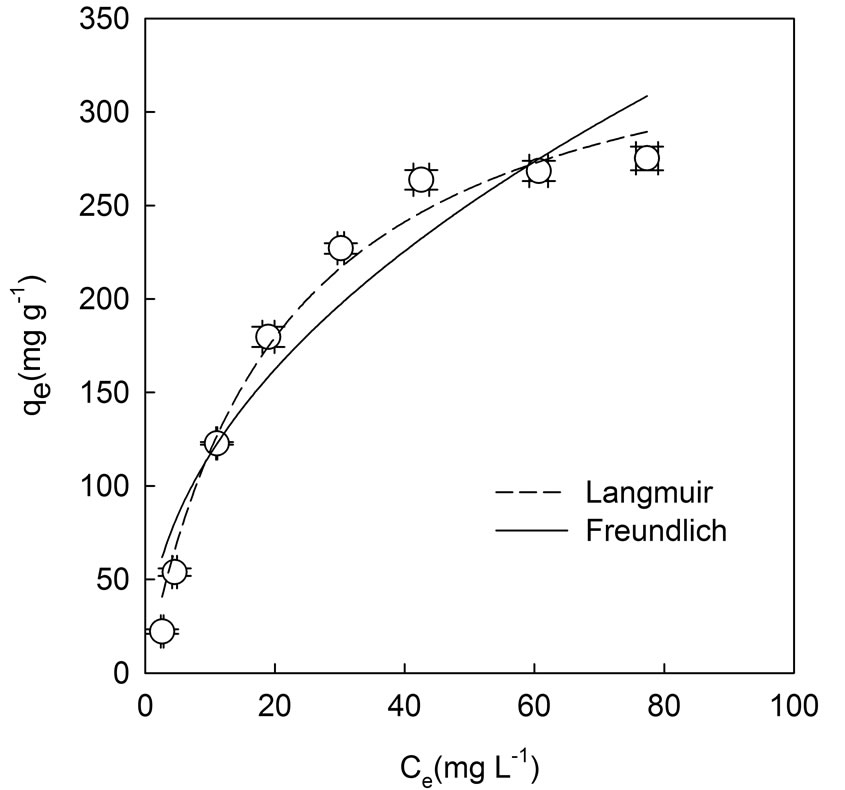
Figure 5. Equilibrium adsorption isotherms for adsorption of C14BDMA onto activated sludge at 25 ℃. (MLSS: 0.25 g L-1; contact time: 4 h ). (Error bars represent one standard deviation of the means).

Table 2. Isotherm constants for the adsorption of C14BDMA onto activated sludge at 25℃.
calculated from the plots, along with the regression correlation coefficients, are given in Table 2. The value of n varies with the heterogeneity of the adsorbent and should be less than 10 and higher than 1 for a favorable adsorption process. The Freundlich constant 1/n obtained in this study was smaller than 1, which indicated that the adsorption process was favorable under studied conditions. According to the correlation coefficient (0.918), the adsorption pattern of C14BDMA onto sludge was also well fitted with the Freundlich isotherm models. This may be due to both homogeneous and heterogeneous distribution of active sites on the surface of the sludge. This observation was in agreement with that of Garcia et al. [20] mentioned above. However, equilibrium partitioning data obtained from the adsorption of cationic surfactants onto municipal sludge [21] and activated carbon cloth [14] were described by the Freundlich isotherm model; these results may be caused by differences in the absorbents rather than the adsorbates.
3.4. Effect of Adsorption Temperature
The effect of temperature on the adsorption isotherm was investigated under isothermal conditions in the temperature range of 15-35℃. Figure 6 shows the temperature dependence of C14BDMA adsorption onto activated sludge. The experimental results indicate that the magnitude of C14BDMA adsorption is closely related to the solution temperature. The adsorption capacity decreased when temperature rose from 15-35℃, indicating that C14BDMA uptake was favored at lower temperatures. Literature has shown many cases in which the increase in temperature caused a decrease in the adsorption capacity of different adsorbates [39,40]. This might be due to the weakening of adsorptive forces between the active sites of the adsorbent and adsorbate species and between the vicinal molecules of the adsorbed phase.
In order to gain insight into the mechanisms involved in the adsorption process, thermodynamic parameters for the present system were calculated at different temperatures. The variations in the enthalpy (ΔH0), and entropy (ΔS0) were calculated were calculated from the slope and intercept of the plot between ln Kd versus 1/T (Figure 7). Kd is the distribution coefficient and T is the absolute temperature (K). ΔG0 can be calculated using the Gibbs Free Energy Equation [41]. According to Table 3, the
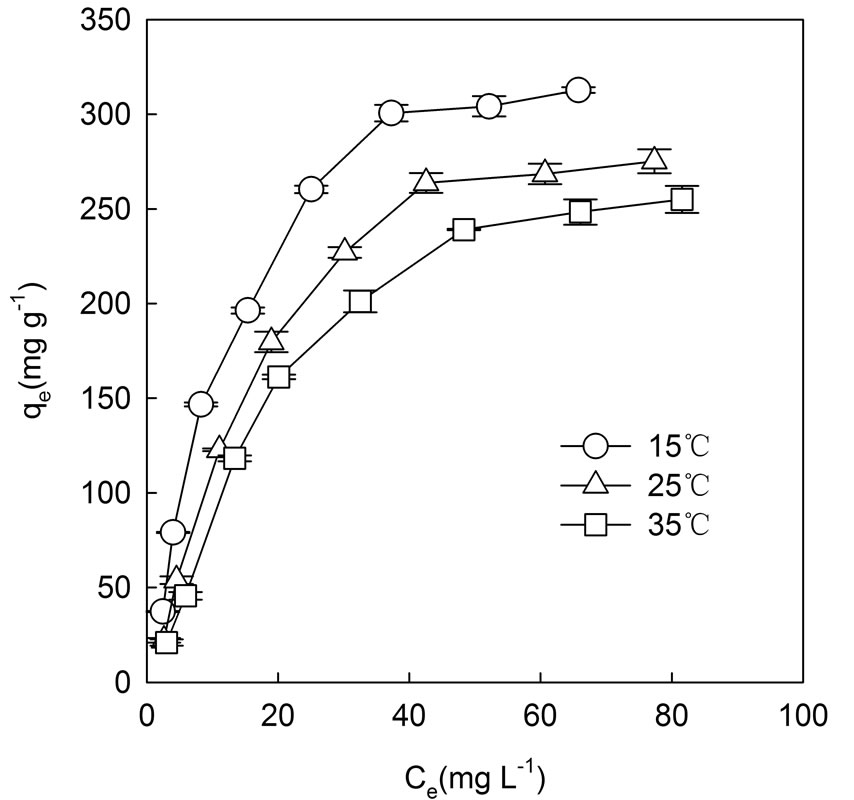
Figure 6. C14BDMA adsorption isotherm onto activated sludge at different temperatures. (Error bars represent one standard deviation of the means).
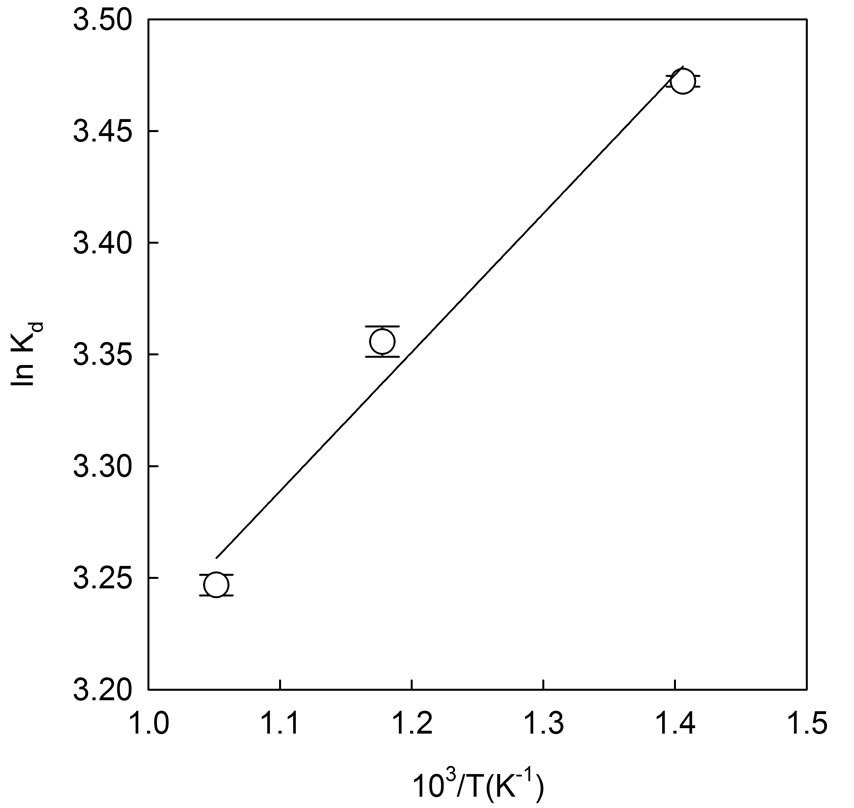
Figure 7. Van’t Hoff plot for the adsorption of C14BDMA onto activated sludge. (Error bars represent one standard deviation of the means).
negative values of ΔG0 indicated that the adsorption process was feasible and spontaneous. In addition, the free energy increased from –3.336 to –2.648 kJ mol-1 with an increase of temperature from15-35℃, showing a decrease in spontaneity.
The negative value of ΔH0 confirmed the exothermic nature of adsorption, also supported by the decrease in value of C14BDMA uptake with the rise in temperature.

Table 3. Thermodynamic parameters of the C14BDMA adsorption onto activated sludge at different temperatures.
Enthalpy change data is useful for distinguishing physisorption and chemisorption. Physisorption is typically associated with heats of adsorption in the 5-20 kJ mol-1 range, while chemisorption is typically associated with much larger ΔH0 values (100-400 kJ mol-1) [42]. The current results suggest that adsorption processes were primarily physisorption.
The entropy change (ΔS0) was –33.94 J mol-1 K-1, which means that C14BDMA sorption to activated sludge corresponds to a decrease in entropy. The negative value of ΔS0 suggests the decreased randomness at the solid/ liquid interface during adsorption. This finding indicates that the changes associated with molecular ordering actually impede the sorption process. C14BDMA is relatively hydrophobic (Log Kow = 3.91) [43], which suggests that hydrophobic interactions may cause sorption to be entropically driven; the current results are in conflict with this notion. Similar results were observed in 17α-Ethinylestradiol (EE2) adsorption onto activated sludge [44]. Hydrophobic interactions are hypothesized to result in greater overall system entropy because of the decrease in the ordering of water molecules surrounding the hydrophobic compounds of interest.
3.5. Effect of pH
Figure 8 shows the pH dependence of C14BDMA adsorption onto activated sludge. As shown, the removal of C14BDMA from aqueous solution was strongly affected by solution pH. The amount of C14BDMA adsorbed onto activated sludge was found to increase from 78.66 to 199.7 mg g-1 in the pH range of 1-9 and attained a constant value above pH 9.
The lower adsorption at lower pH may be attributed to the presence of excess protons in solution competing with cations for the adsorption, and electrostatic repulsion exists between the positively charged surface and the positively charged C14BDMA molecule. pHZPC is the required pH value to give a zero net surface charge on the adsorbent. When pH is lower than pHZPC, the number of negatively charged adsorbent sites decreases, and the number of positively charged surface sites increases, which favors the adsorption of anions [45]. Moreover, the cations in solution may compete with C14BDMA for sorption sites, resulting in the reduction or inhibition of the binding of C14BDMA. Therefore, the sorption of

Figure 8. Effect of pH for the adsorption of C14BDMA onto activated sludge. (C14BDMA concentration: 50 mg L-1; MLSS: 0.25 g L-1; contact time: 4 h; temperature: 25℃). (Error bars represent one standard deviation of the means).
C14BDMA at the low pH range takes place with low removal efficiency.
In general, adsorption of cations is favored at pH > pHpzc. For pH values above the pHZPC, the cell walls will have a negative net charge, which promotes electrostatic attractions between positively charged cations and negatively charged binding sites. Similar observations are shown in literature for cetyl trimethyl ammonium bromide (CTAB) in a pH range of 2-10 using coal samples, as reported by Mishra and Panda [11].
3.6. Effect of Ionic Strength
Industrial wastewaters and natural waters contain many types of electrolytes that have significant effects on the adsorption process, so it is important to evaluate the effects of ionic strength on the removal of C14BDMA from aqueous solutions.
Figure 9 shows the influence of ionic strength on the C14BDMA adsorption. Results showed that an increase in ionic strength led to a decrease of C14BDMA adsorption onto activated sludge. As the concentration of NaCl increased from 0 to 0.40 mol L-1, the amount of C14BDMA uptake decreased from 158.1 to 102.3 mg g-1. Similar trends were also reported in studies on the sorption of 17α-ethinylestradiol onto activated sewage sludge [46] and the sorption of dyes onto metal hydroxide sludge [47].
The aqueous solubilities of different kinds of compounds decrease in the presence of inorganic salts; this is
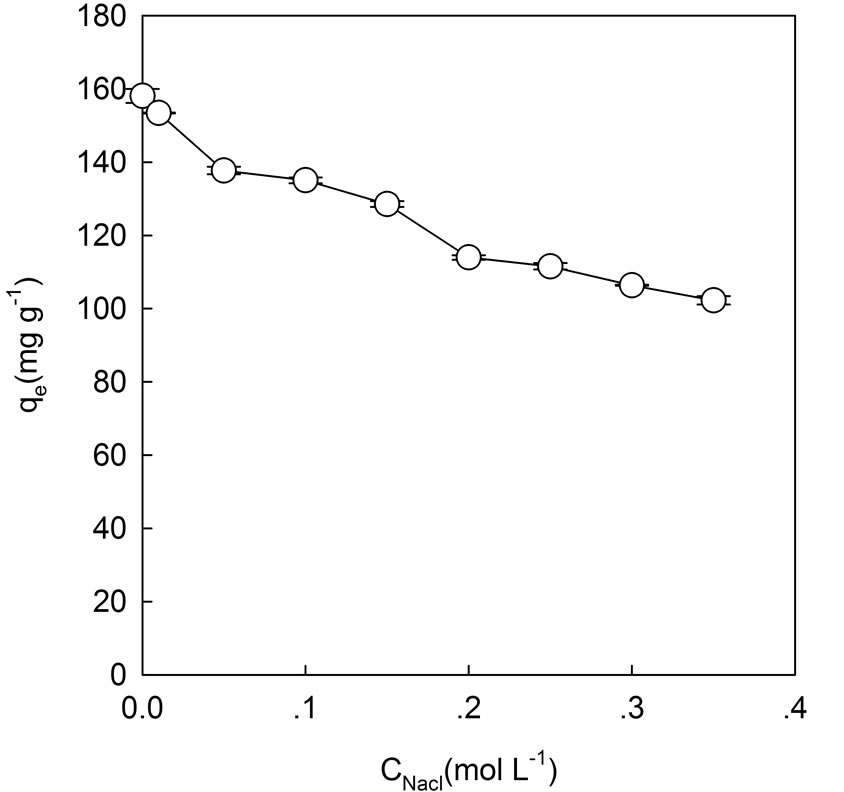
Figure 9. Effect of ionic strength on the adsorption of C14BDMA onto activated sludge (C14BDMA concentration: 50 mg L-1; MLSS: 0.25 g L-1; contact time: 4 h; temperature: 25℃). (Error bars represent one standard deviation of the means).
called the salting-out effect. Therefore, the salting-out effect of NaCl on C14BDMA would be evident with the increase of ion strength, resulting in the reduction of C14BDMA concentration in aqueous solution. This led to a new distribution equilibrium between water and sludge phases and decreased the adsorption of C14BDMA onto the activated sludge [46,48]. Moreover, Na+ and positively charged C14BDMA molecules competed for the same binding sites on the biosorbent surface. With the increase of ionic strength, the number of active sites available for C14BDMA adsorption decreases.
4. Conclusions
In this study, the kinetic studies indicated that the adsorption rate was high at the beginning and the equilibrium time was 2 h. The kinetics of C14BDMA adsorption onto activated sludge followed the pseudo second-order model. The curves obtained for the Langmuir and Freundlich isotherm models described the experimental equilibrium data well, indicating both heterogeneous and homogeneous distributions in the active site on the surface. The adsorption of C14BDMA onto activated sludge decreased with increasing temperature. Thermodynamic parameters, including the Gibbs free energy (ΔG0), enthalpy (ΔH0), and entropy (ΔS0), indicated that adsorption of C14BDMA onto activated sludge was feasible, spontaneous and exothermic in the temperature range of 15-35℃. The adsorption of C14BDMA on activated sludge was found to be low in acidic solution but increases with an increase in pH and remains constant in the neutral and alkaline pH regions. As the concentration of NaCl increased, the amount of C14BDMA uptake decreased. The experimental results indicated that the activated sludge could be used as an alternative, inexpensive and effective material to remove high amounts of C14BDMA from wastewater.
5. Acknowledgements
This work was financially supported by the National water pollution control and treatment technological project (No. 2008ZX07314-002) and the National Natural Science Foundation of China (No. 50908117).
REFERENCES
- E. Martinez-Carballo, A. Sitka, C. Gonzalez-Barreiro, N. Kreuzinger, M. Furhacker, S. Scharf and O. Gans, “Determination of Selected Quaternary Ammonium Compounds by Liquid Chromatography with Mass Spectrometry. Part I. Application to Surface, Waste and Indirect Discharge Water Samples in Austria,” Environmental Pollution, Vol. 145, No. 2, 2007, pp. 489-496. doi:10.1016/j.envpol.2006.04.033
- N. Kreuzinger, M. Fuerhacker, S. Scharf, M. Uhl, O. Gans and B. Grillitsch, “Methodological Approach towards the Environmental Significance of Uncharacterized Substances--Quaternary Ammonium Compounds as an Example,” Desalination, Vol. 215, No. 1-3, 2007, pp. 209-222. doi:10.1016/j.desal.2006.10.036
- L. Games, J. King and R. Larson, “Fate and Distribution of a Quaternary Ammonium Surfactant, Octadecyl Trimethyl Ammonium Chloride (OTAC), in Wastewater Treatment,” Environmental Science & Technology, Vol. 16, No. 8, 1982, pp. 483-488. doi:10.1021/es00102a011
- H. Sun, A. Takata, N. Hata, I. Kasahara and S. Taguchi, “Transportation and Fate of Cationic Surfactant in River Water,” Journal of Environmental Monitoring, Vol. 5, No. 6, 2003, pp. 891-895. doi:10.1039/b308988f
- R. Boethling, “Environmental Fate and Toxicity in Wastewater Treatment of Quaternary Ammonium Surfactants,” Water Research, Vol. 18, No. 9, 1984, pp. 1061- 1076. doi:10.1016/0043-1354(84)90220-3
- U. Tezel, J. Pierson and S. Pavlostathis, “Effect of Didecyl Dimethyl Ammonium Chloride on Nitrate Reduction in a Mixed Methanogenic Culture,” Water Science and Technology: A Journal of the International Association on Water Pollution Research, Vol. 57, No. 4, 2008, pp. 541-546.
- U. Tezel, J. Pierson, S. Pavlostathis, “Effect of Polyelectrolytes and Quaternary Ammonium Compounds on the Anaerobic Biological Treatment of Poultry Processing Wastewater,” Water Research, Vol. 41, No. 6, 2007, pp. 1334-1342. doi:10.1016/j.watres.2006.12.005
- P. Fernandez, A. Alder, J. Marc and W. Giger, “Determination of the Quaternary Ammonium Surfactant Ditallowdimethylammonium in Digested Sludges and Marine Sediments by Supercritical Fluid Extraction and Liquid Chromatography with Postcolumn Ion-Pair Formation,” Analytical Chemistry, Vol. 68, No. 5, 1996, pp. 921-929. doi:10.1021/ac9505482
- F. Merino, S. Rubio and D. Perez-Bendito, “Mixed Aggregate-Based Acid-Induced Cloud-Point Extraction and Ion-Trap Liquid Chromatography-Mass Spectrometry for the Determination of Cationic Surfactants in Sewage Sludge,” Journal of Chromatography A, Vol. 998, No. 1-2, 2003, pp. 143-154. doi:10.1016/S0021-9673(03)00565-X
- H. Sutterlin, R. Alexy, A. Coker and K. Kummerer, “Mixtures of Quaternary Ammonium Compounds and Anionic Organic Compounds in the Aquatic Environment: Elimination and Biodegradability in the Closed Bottle Test Monitored by LC-MS/MS,” Chemosphere, Vol. 72, No. 3, 2008, pp. 479-484. doi:10.1016/j.chemosphere.2008.03.008
- S. Mishra and D. Panda, “Studies on the Adsorption of Brij- 35 and CTAB at the Coal-Water Interface,” Journal of colloid and interface science, Vol. 283, No. 2, 2005, pp. 294-299. doi:10.1016/j.jcis.2004.09.017
- M. Ghiaci, R. Kia and R. Kalbasi, “Investigation of Thermodynamic Parameters of Cetyl Pyridinium Bromide Sorption onto ZSM-5 and Natural Clinoptilolite,” The Journal of Chemical Thermodynamics, Vol. 36, No. 2, 2004, pp. 95-100. doi:10.1016/j.jct.2003.09.002
- C. Basar, A. Karagunduz, A. Cakici and B. Keskinler, “Removal of Surfactants by Powdered Activated Carbon and Microfiltration,” Water Research, Vol. 38, No. 8, 2004, pp. 2117-2124. doi:10.1016/j.watres.2004.02.001
- O. Duman and E. Ayranci, “Adsorptive Removal of Cationic Surfactants from Aqueous Solutions onto High-Area Activated Carbon Cloth Monitored by in Situ UV Spectroscopy,” Journal of Hazardous Materials, Vol. 174, No. 1-3, 2010, pp. 359-367. doi:10.1016/j.jhazmat.2009.09.058
- H. Tamai, M. Kunihiro and H. Yasuda, “Adsorption of Tetraalkylammonium Ions on Microporous and Mesoporous Activated Carbons Prepared from Vinylidene Chloride Copolymer,” Journal of Colloid and Interface Science, Vol. 275, No. 1, 2004, pp. 44-47. .doi:10.1016/j.jcis.2003.12.039
- J. Laurent, M. Pierra, M. Casellas and C. Dagot, “Fate of Cadmium in Activated Sludge after Changing Its Physico-Chemical Properties by Thermal Treatment,” Chemosphere, Vol. 77, No. 6, 2009, pp. 771-777. doi:10.1016/j.chemosphere.2009.08.024
- V. Ochoa-Herrera and R. Sierra-Alvarez, “Removal of Perfluorinated Surfactants by Sorption onto Granular Activated Carbon, Zeolite and Sludge,” Chemosphere, Vol. 72, No. 10, 2008, pp. 1588-1593. doi:10.1016/j.chemosphere.2008.04.029
- A. Kipopoulou, A. Zouboulis, C. Samara and T. Kouimtzis, “The Fate of Lindane in the Conventional Activated Sludge Treatment Process,” Chemosphere, Vol. 55, No. 1, 2004, pp. 81-91. doi:10.1016/j.chemosphere.2003.11.020
- M. Clara, S. Scharf, C. Scheffknecht and O. Gans, “Occurrence of Selected Surfactants in Untreated and Treated Sewage,” Water Research, Vol. 41, No. 19, 2007, pp. 4339-4348. doi:10.1016/j.watres.2007.06.027
- M. Garcia, E. Campos, J. Sanchez-Leal and F. Comelles, “Sorption of Alkyl Benzyl Dimethyl Ammonium Compounds by Activated Sludge,” Journal of Dispersion Science and Technology, Vol. 27, 2006, pp. 739-744. doi:10.1080/01932690600662554
- Z. Ismail, U. Tezel and S. Pavlostathis, “Sorption of Quaternary Ammonium Compounds to Municipal sludge,” Water Research, Vol. 44, No. 7, 2010, pp. 2303-2313. doi:10.1016/j.watres.2009.12.029
- C. Zhang, U. Tezel, K. Li, D. Liu, R. Ren, J. Du and S. Pavlostathis, “Evaluation and Modeling of Benzalkonium Chloride Inhibition and Biodegradation in Activated Sludge,” Water Research, Vol. 45, No. 3, 2011, pp. 1238-1246. doi:10.1016/j.watres.2010.09.037
- M. Idouhar and A. Tazerouti, “Spectrophotometric Determination of Cationic Surfactants Using Patent Blue V: Application to the Wastewater Industry in Algiers,” Journal of Surfactants and Detergents, Vol. 11, No. 4, 2008, pp. 263-267. doi:10.1007/s11743-008-1079-1
- X. Wang, G. Yin, Q. Liu, et al., “The Monitoring Analysis Method of Water and Waste Water,” 4th Edition, China Environmental Protection Agency, China Environmental Science Press, 2002.
- M. Garcia, E. Campos, J. Sanchez-Leal and F. Comelles, “Structure-Activity Relationships for Sorption of Alkyl Trimethyl Ammonium Compounds on Activated Sludge,” Tenside, Surfactants, Detergents, Vol. 41, No. 5, 2004, pp. 235-239.
- M. Chiou and H. Li, “Adsorption Behavior of Reactive Dye in Aqueous Solution on Chemical Cross-Linked Chitosan Beads,” Chemosphere, Vol. 50, No. 8, 2003, pp. 1095-1105. doi:10.1016/S0045-6535(02)00636-7
- D. Ju, I. Byun, J. Park, C. Lee, G. Ahn and T. Park, “Biosorption of a Reactive Dye (Rhodamine-B) from an Aqueous Solution Using Dried Biomass of Activated Sludge,” Bioresource Technology, Vol. 99, No. 17, 2008, pp. 7971-7975. doi:10.1016/j.biortech.2008.03.061
- S. Lagergren, “Zur Theorie der Sogenannten Adsorption gel Ster Stoffe, Kungliga Svenska Vetenskapsakademiens,” Handlingar, Vol. 24, No. 4, 1898, pp. 1-39.
- Y. Ho and G. McKay, “The Kinetics of Sorption of Divalent Metal Ions onto Sphagnum Moss Peat,” Water Research, Vol. 34, No. 3, 2000, pp. 735-742. doi:10.1016/S0043-1354(99)00232-8
- Y. Ho, G. McKay, D. Wase and C. Forster, “Study of the Sorption of Divalent Metal Ions on to Peat,” Adsorption Science & Technology, Vol. 18, No. 7, 2000, pp. 639-650. doi:10.1260/0263617001493693
- R. Juang, F. Wu and R. Tseng, “Mechanism of Adsorption of Dyes and Phenols from Water Using Activated Carbons Prepared from Plum Kernels,” Journal of Colloid and Interface Science, Vol. 227, No. 2, 2000, pp. 437-444. doi:10.1006/jcis.2000.6912
- Y. Shu, L. Li, Q. Zhang and H. Wu, “Equilibrium, Kinetics and Thermodynamic Studies for Sorption of Chlorobenzenes on CTMAB Modified Bentonite and Kaolinite,” Journal of Hazardous Materials, Vol. 173, No. 1-3, 2010, pp. 47-53. doi:10.1016/j.jhazmat.2009.08.043
- G. Walker, L. Hansen, J. Hanna and S. Allen, “Kinetics of a Reactive Dye Adsorption onto Dolomitic Sorbents,” Water Research, Vol. 37, No. 9, 2003, pp. 2081-2089. doi:10.1016/S0043-1354(02)00540-7
- N. Caner, I. Kiran, S. Ilhan and C. Iscen, “Isotherm and Kinetic Studies of Burazol Blue ED Dye Biosorption by Dried Anaerobic Sludge,” Journal of Hazardous Materials, Vol. 165, No. 1-3, 2009, pp. 279-284. doi:10.1016/j.jhazmat.2008.09.108
- I. Mall, V. Srivastava, N. Agarwal and I. Mishra, “Adsorptive Removal of Malachite Green Dye from Aqueous Solution by Bagasse Fly Ash and Activated Carbon-Kinetic Study and Equilibrium Isotherm Analyses,” Colloids and Surfaces A: Physicochemical and Engineering Aspects, Vol. 264, No. 1-3, 2005, pp. 17-28. doi:10.1016/j.colsurfa.2005.03.027
- I. Langmuir, “The Adsorption of Gases on Plane Surfaces of Glass, Mica and Platinum,” Journal of the American Chemical Society, Vol. 40, No. 9, 1918, pp. 1361-1403. doi:10.1021/ja02242a004
- H. Freundlich, “Over the Adsorption in Solution,” The Journal of Chemical Physics, Vol. 57, 1906, pp. 385-470.
- U. Tezel, J. Pierson and S. Pavlostathis, “Fate and Effect of Quaternary Ammonium Compounds on a Mixed Methanogenic Culture,” Water Research, Vol. 40, No. 19, 2006, pp. 3660-3668. doi:10.1016/j.watres.2006.06.019
- H. Park and C. Na, “Adsorption Characteristics of Anionic Nutrients onto the PP-g-AA-Am Non-Woven Fabric Prepared by Photoinduced Graft and Subsequent Chemical Modification,” Journal of Hazardous Materials, Vol. 166, No. 2-3, 2009, pp. 1201-1209.
- H. Senturk, D. Ozdes, A. Gundogdu, C. Duran and M. Soylak, “Removal of Phenol from Aqueous Solutions by Adsorption onto Organomodified Tirebolu Bentonite: Equilibrium, Kinetic and Thermodynamic Study,” Journal of Hazardous Materials, Vol. 172, No. 1, 2009, pp. 353-362. doi:10.1016/j.jhazmat.2009.07.019
- W. Cheng, S. Wang, L. Lu, W. Gong, X. Liu, B. Gao and H. Zhang, “Removal of Malachite Green (MG) from Aqueous Solutions by Native and Heat-Treated Anaerobic Granular Sludge,” Biochemical Engineering Journal, Vol. 39, No. 3, 2008, pp. 538-546. doi:10.1016/j.bej.2007.10.016
- W. Weber Jr and W. Huang, “A Distributed Reactivity Model for Sorption by Soils and Sediments. Intraparticle Heterogeneity and Phase-Distribution Relationships under Nonequilibrium Conditions,” Environmental Science & Technology, Vol. 30, No. 3, 1996, pp. 881-888.
- J. Yang, “Fate and Effect of Alkyl Benzyl Dimethyl Ammonium Chloride in Mixed Aerobic and Nitrifying Cultures,” MS Thesis, Georgia Institute of Technology, Atlanta, GA, 2007.
- K. Xu, W. Harper Jr and D. Zhao, “17α-Ethinylestradiol Sorption to Activated Sludge Biomass: Thermodynamic Properties and Reaction Mechanisms,” Water Research, Vol. 42, No. 12, 2008, pp. 3146-3152. doi:10.1016/j.watres.2008.03.005
- V. Garg, R. Gupta, A. Bala Yadav and R. Kumar, “Dye Removal From Aqueous Solution by Adsorption on Treated Sawdust,” Bioresource Technology, Vol. 89, No. 2, 2003, pp. 121-124. doi:10.1016/S0960-8524(03)00058-0
- Y. Feng, Z. Zhang, P. Gao, H. Su, Y. Yu and N. Ren, “Adsorption Behavior of EE2 (17α-Ethinylestradiol) onto the Inactivated Sewage Sludge: Kinetics, Thermodynamics and Influence Factors,” Journal of Hazardous Materials, Vol. 175, No. 1-3, 2009, pp. 970-976. doi:10.1016/j.jhazmat.2009.10.105
- S. Netpradit, P. Thiravetyan, S. Towprayoon, “Adsorption of Three Azo Reactive Dyes by Metal Hydroxide Sludge: Effect of Temperature, pH, and Electrolytes,” Journal of Colloid and Interface Science, Vol. 270, No. 2, 2004, pp. 255-261. doi:10.1016/j.jcis.2003.08.073
- M. Gorgenyi, J. Dewulf, H. Van Langenhove and K. Heberger, “Aqueous Salting-Out Effect of Inorganic Cations and Anions on Non-Electrolytes,” Chemosphere, Vol. 65, No. 5, 2006, pp. 802-810. doi:10.1016/j.chemosphere.2006.03.029

